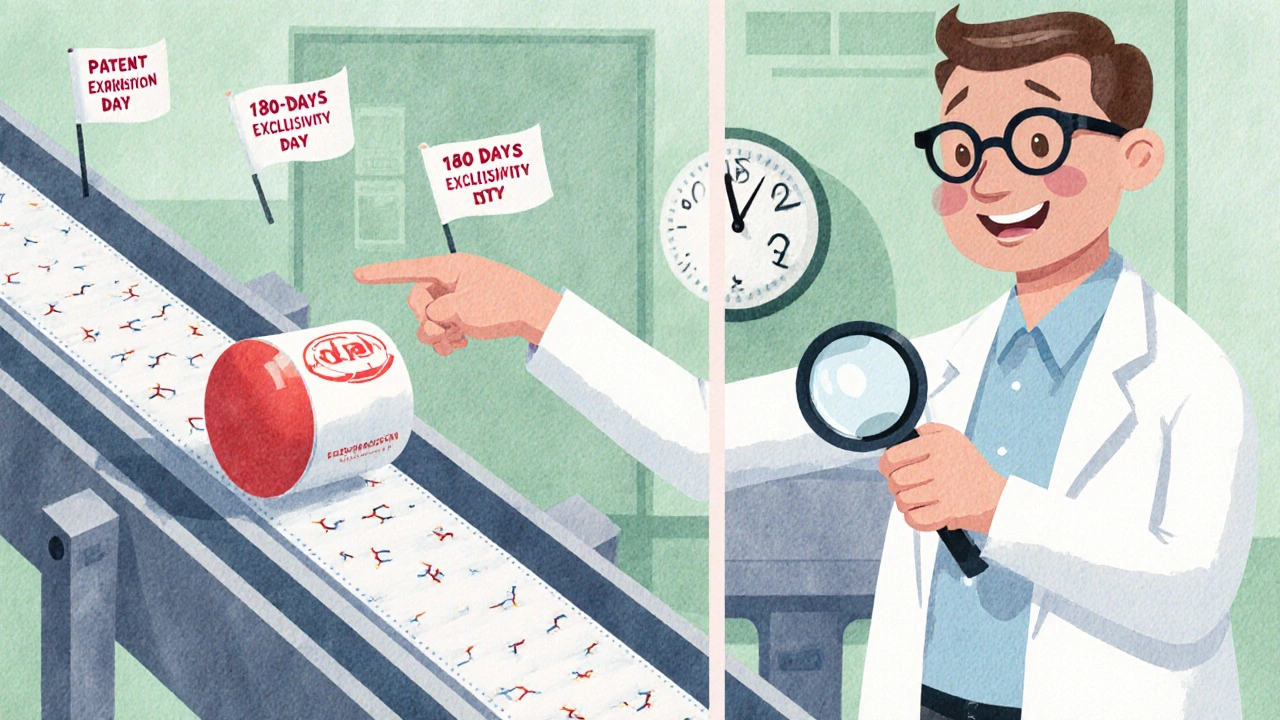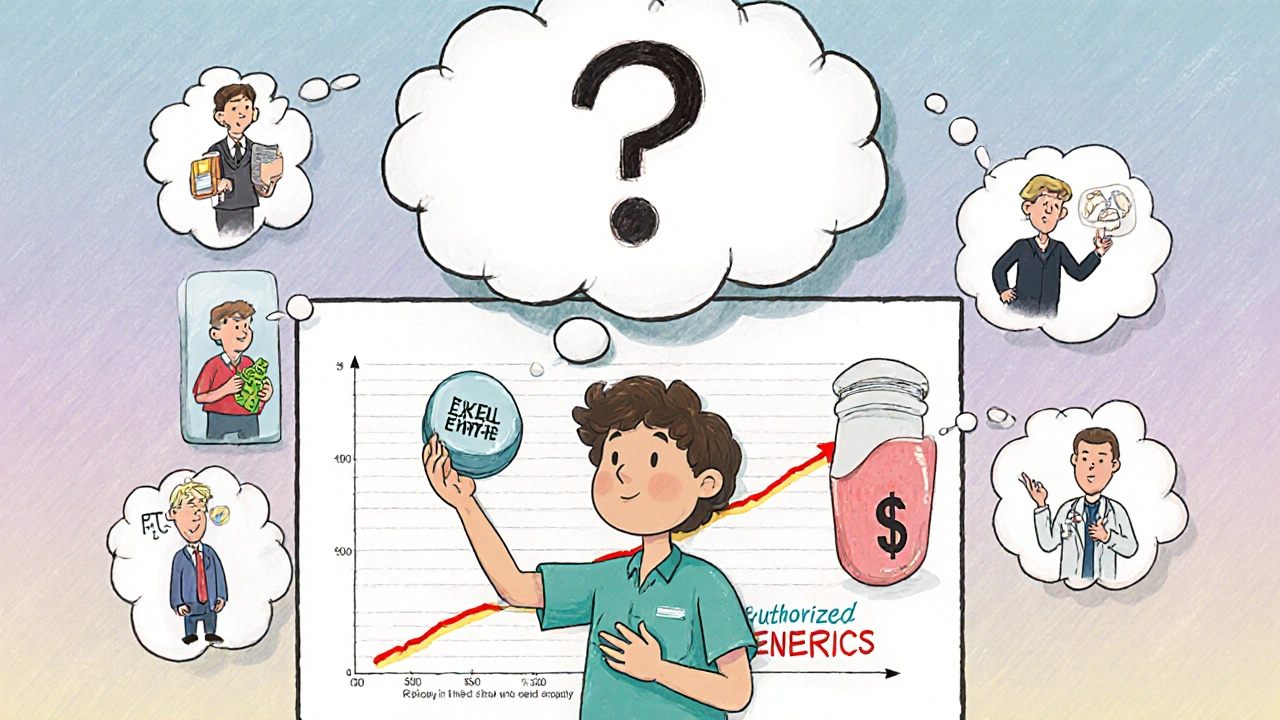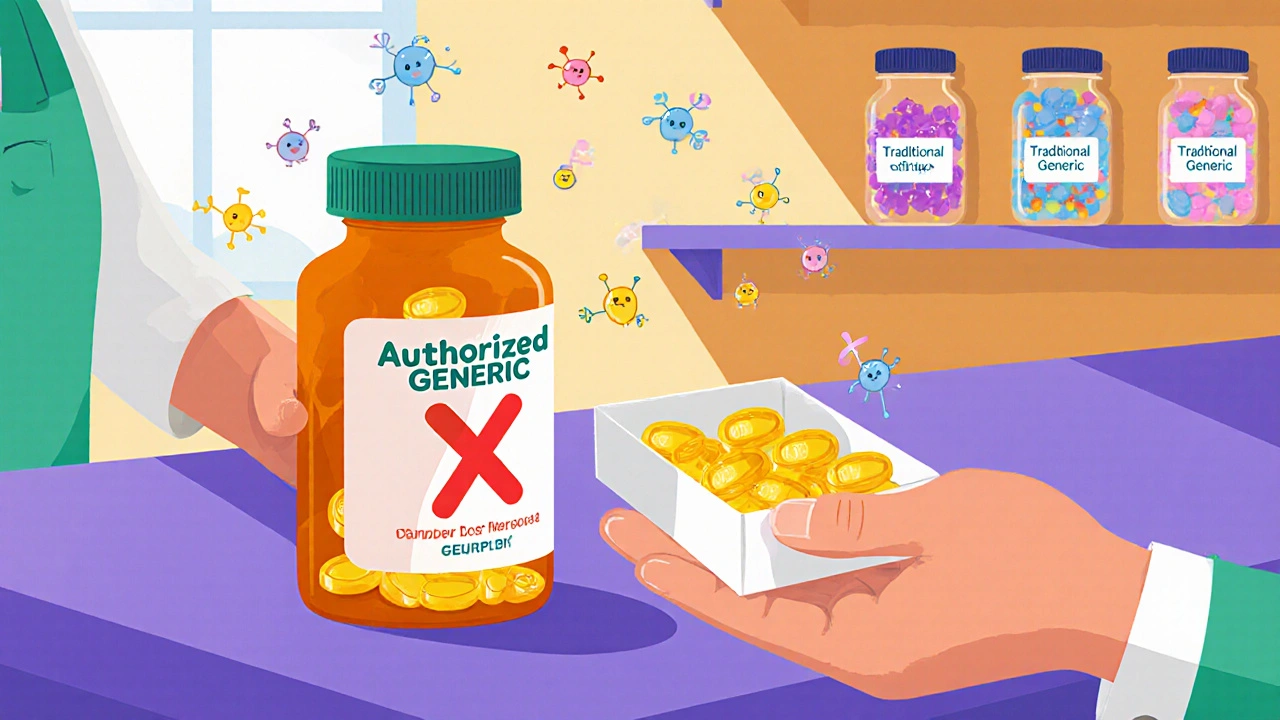When a brand-name drug’s patent runs out, the market doesn’t just open up to cheap generics-it gets complicated. That’s where authorized generics come in. These aren’t your typical generics. They’re the exact same pills, capsules, or injections made by the original brand company, just sold without the brand name on the label. And they show up right when the patent expires, often before any other generic even hits the shelves.
What Exactly Is an Authorized Generic?
An authorized generic is the brand drug, made in the same factory, with the same active and inactive ingredients, the same dosage, and the same performance. The only difference? No brand name. No logo. No fancy packaging. It’s the same product, repackaged and sold under a different label-usually by a subsidiary of the original company. For example, when Pfizer’s Celebrex lost patent protection, its authorized generic, made by Greenstone Pharmaceuticals (a Pfizer-owned company), hit the market. Same active ingredient-celecoxib. Same fillers. Same coating. Same everything. The only thing changed was the label. Unlike traditional generics, which must prove they’re bioequivalent through an Abbreviated New Drug Application (ANDA), authorized generics don’t need FDA approval at all. They’re marketed under the original New Drug Application (NDA). That means they skip the entire bioequivalence testing process. The FDA confirms they’re therapeutically equivalent simply because they’re the exact same drug.Why Do Brand Companies Launch Them?
It’s not about helping patients save money-though that’s a side effect. It’s about protecting revenue. When a patent expires, the first generic manufacturer gets 180 days of exclusive rights to sell the generic version under the Hatch-Waxman Act. That’s a huge window to capture market share. But if the brand company launches its own generic at the same time, it splits the market. The first generic can’t dominate. And prices drop faster than they would if only one generic entered. A 2022 study in Health Affairs found that between 2010 and 2019, there were 854 authorized generic launches in the U.S. The biggest spike? 2014. That’s not a coincidence. It’s when dozens of top-selling drugs lost patent protection. Companies like Johnson & Johnson, AbbVie, and Merck used authorized generics as a tool to keep their slice of the pie. The Federal Trade Commission (FTC) confirmed this strategy in its 2011 report: when brand companies launched authorized generics during the 180-day exclusivity window, prices dropped 15-20% more than in markets without them. Consumers paid less. But the brand company still made money-just not as much as before.Authorized Generics vs. Traditional Generics
It’s easy to assume all generics are the same. They’re not. | Feature | Authorized Generic | Traditional Generic | |--------|---------------------|---------------------| | Manufacturer | Original brand company or its subsidiary | Independent generic manufacturer | | Ingredients | Identical to brand (active + inactive) | Only active ingredient must match; excipients can differ | | FDA Approval | Not required (uses original NDA) | Required (ANDA submission) | | Listed in Orange Book? | No | Yes | | Price | Usually lower than brand, often higher than traditional generic | Lowest price point in market | | Therapeutic Consistency | Highest-no formulation changes | Can vary slightly due to different fillers | This matters most for drugs with a narrow therapeutic index-like levothyroxine (for thyroid), warfarin (blood thinner), or seizure meds. A tiny difference in inactive ingredients can throw off how the drug works. Patients stabilized on brand-name drugs sometimes crash when switched to a traditional generic. But with an authorized generic? No change. Same formula. Same results.
Why Patients Get Confused
Here’s the problem: patients don’t know the difference. A 2023 survey by Pharmacy Times found that 68% of pharmacists say patients are confused about authorized generics. One patient on Drugs.com wrote: “I got this ‘generic’ but it looks identical to the brand I used before-is this actually generic?” They’re not wrong. It is identical. But the word “generic” implies something cheaper, less reliable, different. When the pill looks and feels exactly like the brand, patients assume they got ripped off. Or worse-they think the pharmacy gave them the wrong drug. Pharmacists report spending extra time explaining that an authorized generic isn’t a knockoff. It’s the real thing. That’s why the FDA now requires clearer labeling, and why some pharmacy systems (like Epic) now flag authorized generics separately in their software. But many smaller pharmacies still don’t have the tools or training.Impact on the Market
The data shows a clear pattern. In 2022, 38 of the top 50 brand drugs facing patent expiration had an authorized generic launched within 12 months. That’s up from 32% in 2022. And it’s not slowing down. Evaluate Pharma predicts 45% of major branded drugs will have authorized generics by 2027. Pharmacy Benefit Managers (PBMs) like Express Scripts and OptumRx actively push them. Why? Because they’re reliable. They reduce the risk of therapeutic failure. Express Scripts found 28% higher utilization of authorized generics compared to traditional generics in their formularies. But not everyone sees this as a win. The Generic Pharmaceutical Association (GPhA) argues that authorized generics delay true competition. If the brand company launches its own generic, the first independent generic can’t capture the full 180-day exclusivity. That means fewer players enter the market, and long-term prices don’t drop as much. Dr. Jerry Avorn from Harvard put it bluntly in a 2019 JAMA commentary: “Authorized generics represent a sophisticated market manipulation strategy that ultimately benefits brand manufacturers more than consumers in the long term.”
What’s Changing Now?
The FDA updated its list of authorized generics in October 2025, now including 1,247 products. That’s up from 854 in 2019. The market is growing. Meanwhile, Congress is looking at restricting the practice. The Promoting Competition in Pharmaceutical Markets Act, introduced in 2023, would ban brand companies from launching authorized generics during the 180-day exclusivity window. If passed, it could force companies to choose: either let the first generic have the field, or lose the ability to compete at all. The FTC is also running a new study, with preliminary results expected in early 2026. Will the old rules still hold? Will prices continue to drop? Or have manufacturers found new ways to game the system?What This Means for You
If you’re taking a brand-name drug that’s about to go generic, here’s what to ask your pharmacist:- Is there an authorized generic available?
- Is it the same as my current prescription?
- Will switching to it affect how the drug works?
Bottom Line
Authorized generics aren’t a loophole. They’re a calculated move by drug companies to hold onto profits while still letting prices fall. They’re not evil. They’re not a scam. But they’re not pure altruism, either. For patients, they’re a mixed bag. On one hand, they offer unmatched consistency and can prevent dangerous switches. On the other, they can delay true competition and confuse consumers. The real winners? Those who understand the difference-and ask the right questions.As the patent cliff keeps coming-more drugs lose protection every year-authorized generics will keep showing up. The question isn’t whether they’ll exist. It’s whether the system will adapt to make them work better for patients, not just for profits.


Patrick Goodall
November 25, 2025 AT 19:28Kaylee Crosby
November 26, 2025 AT 10:07Mariam Kamish
November 26, 2025 AT 15:46Emma Hanna
November 28, 2025 AT 10:06Karen Ryan
November 28, 2025 AT 15:43Lawrence Zawahri
November 29, 2025 AT 10:04Benjamin Gundermann
November 29, 2025 AT 23:19Dirk Bradley
November 30, 2025 AT 03:30Manish Pandya
December 1, 2025 AT 03:36Adesokan Ayodeji
December 3, 2025 AT 01:15Terry Bell
December 4, 2025 AT 05:13Rachelle Baxter
December 4, 2025 AT 11:22